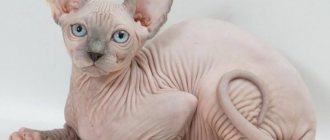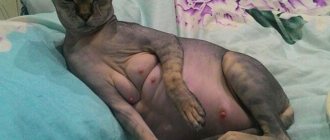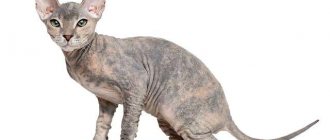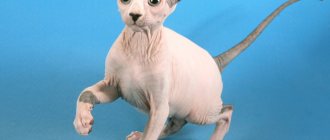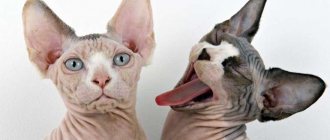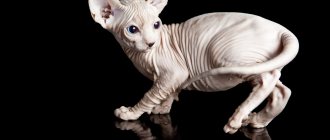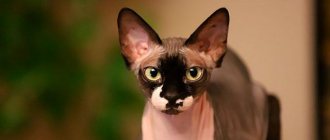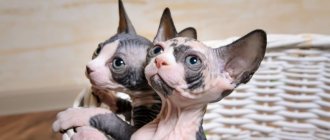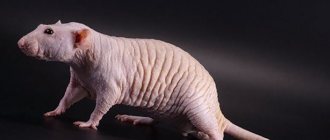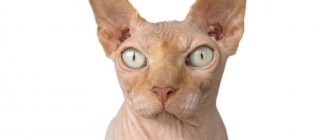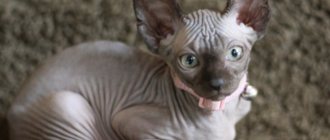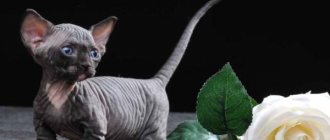20.10.2019
| no comments
To some, the Canadian Sphynx, a representative of the hairless cat breeds, seems to be the most charming creature in the world, while others consider it unsightly, an “alien.”
But everyone will agree that these cats have an original, spectacular appearance.
These owners of the enchanting, intense gaze of large lemon-shaped eyes, lint-free suede skin, large ears and wonderful folds always attract attention.
Despite the fact that this breed began to be bred in Minnesota, its name indicates Canadian origin.
Indeed, the hairless kitten appeared in this country in the mid-60s from a simple shorthaired cat in Ontario.
The amazed owners raised the baby, crossed him with his mother and received a whole litter of hairless kittens. But they were unable to understand exactly how the transmission of this genotype could be stabilized.
A more thorough study of this phenomenon took place ten years later in the state of Minnesota, where an ordinary cat also unexpectedly had a hairless kitten, nicknamed Epidermis.
Later, a similar female person was found for him. They became the ancestors of this species. Similar individuals from the Devonrex breed were used to secure the genotype.
The new breed was given the name Sphynx, since the first attempts to breed it were made in Ontario.
The European branch of the Canadian Sphynx originated in Holland, where Paloma and Pinky, found on the street, were brought from America. In Ukraine and Russia, breeding of the breed began with the wonderful couple Nefertiti and Pelmeni, also brought from the United States. This is how the Don Sphynxes and Peterbolts appeared.
Canadian Sphynx: description of breed standards:
- The head is medium-sized, wedge-shaped, rounded with prominent cheekbones, slightly longer than wide;
- a wide bridge of the nose with a short nose covered with short fur;
- large ears set far apart with a wide base, with rounded tips without tassels;
- there are no whiskers, if the individual still has them, this is not considered a defect;
- large eyes have the shape of a lemon, the color can be different, depending on the color;
- the body is muscular, pear-shaped, with a wide chest;
- the hind legs are longer than the front legs;
- the fingers of the limbs are long, the tips may be pubescent;
- the tail is bare, has the appearance of a whip, a tassel is allowed at the end;
- there are many folds on the neck, limbs, forehead, body;
- different colors: chocolate, piebald, gray, white, red, etc.
In appearance, the animal seems incredibly light. But don’t delude yourself, cats have a sensitive mass for their size. The average weight of an adult sphinx is about 4 kilograms, but there are also larger individuals whose weight reaches 6 kg.
The main difference between the Canadian Sphynx and the Don “brother” is the number of folds. The representative of Canada has many more. These cats always curl their tail into a donut and press it to their body. The Sphynx breed is characterized by maximum sweating. The pet must be periodically wiped with a napkin so that sweat does not dry on the body or remain on clothes or furniture.
Character
By their nature, sphinxes are absolutely not similar to cats. They rightfully consider themselves full members of the family. You can compare a representative of this breed to a three-year-old child. He is just as inquisitive and always explores all areas and new things in the house.
The cat will charm you with his incredible love; he will never refuse the opportunity to cuddle, warm up on his lap, and even on his owner’s head. By the way, these animals have a healing gift, they perfectly soothe pain, located in the area of concern.
There is no jealousy in these animals. They are ready to get along well with all family members and other pets in the house. Canadian Sphynxes do not have aggression; they can endure the pestering of restless children for a long time.
Moreover, they themselves do not sit still, are always ready for games and entertainment, and are not averse to listening to the owner if he wants to talk. He will purr in response.
It should not be surprising that these cats are often participants in commercials. They are easy to learn.
It should be taken into account that the Canadian Sphynxes are characterized by pride. They won’t ask you for any handouts or goodies. They will simply take them from the table if they happen to be there. Moreover, even a well-fed cat will not refuse to “walk” around the dining area and look for a treat.
The Sphinx's favorite pastime is overcoming obstacles. It is worth equipping special stands for your pet, on which he could climb and sleep. Toys for entertainment will also come in handy.
Breeding and care
Sphynx cats have an elevated body temperature, which keeps them warm in lieu of their missing fur. The normal level is 38°C. Their heartbeat is also different from other cats; it is almost twice as frequent.
Due to the increased body temperature, the animal's metabolism is accelerated. You need to carefully monitor your pet's diet. One of the main problems with this breed is obesity. Dermatitis, hyperplasia, acne, etc. occur in Sphynxes. If symptoms of diseases appear, you must contact a veterinarian.
Since the cat sweats a lot, it is necessary to use sanitary napkins to wipe the skin, including on the tail. Periodically, about once a month, the pet needs to be washed using a special or baby shampoo. You should clean your Sphynx's ears regularly. The accumulated secretion does not pose a threat, but it looks ugly.
Solar treatments will help make your color brighter. But the animal needs to be accustomed to them gradually, starting with walks in shaded places.
The main conditions for maintaining the health of a pet are:
- maintaining optimal air temperature and heat in the house;
- quality food; timely castration;
- periodic mating for unsterilized individuals.
What to feed
Feeding these animals may seem like no problem; they are omnivores. Indeed, the Sphynx cat eats any food with appetite. Moreover, the pets have an excellent appetite. Accelerated metabolism promotes rapid digestion of food.
However, it is necessary to pay attention to your pet’s nutrition. First of all, these cats hardly chew. Therefore, the consistency of food must be appropriate. Secondly, they can eat meat, chocolate and pickled cucumber with the same appetite. But they can only consume such products in minimal quantities.
Good options for such cats are:
- deep-frozen lean meat,
- liver,
- vegetables,
- fermented milk products,
- cereal porridges,
- raw egg yolk.
Under no circumstances should you give your pet cheese, sausage, pastries or cakes. The optimal diet for these cats is special dry food.
How long do Canadian Sphynxes live?
Despite their unique appearance and differences in structure, the Canadian Sphynx does not differ from other breeds in life expectancy. The average age is 14 years. However, in the history of the sphinxes there is a long-lived legendary Bambi, who managed to celebrate his 30th anniversary.
Breeding
Canadian Sphynx cats can be homozygous or heterozygous. Pedigree kittens without deviations can only appear if homozygous individuals are crossed.
It is sometimes difficult to identify these animals externally without special skills; their differences are subtle. Therefore, professionals breed these pets.
You can buy a kitten from Canadian Sphynx breeders in Kyiv, Moscow, Minsk, or you can find them on the Internet.
Cost of Canadian Sphynxes
The cost of a kitten depends on the pedigree of its parents and the individual characteristics of the baby. On average for a pet with a good pedigree:
- the price in Ukraine is about three thousand hryvnia;
- the price in Russia fluctuates over a wide range and can reach 9-14 thousand rubles.
Source: https://poroda-koshek.com/kanadskij-sfinks/
Characteristics of the Don Sphynx - character and habits
The peculiar appearance of the Don breed sphinxes makes an indelible impression. Unusual hairless cats with large ears and folds all over their bodies are affectionate, not cat-like wise, and have a friendly disposition. With its expression of extreme concentration on its folded muzzle, the Donchak looks more like a pensive alien than a representative of the feline family.
Don cats are very social animals and love tactile contact. For good behavior, the Donchak expects a mandatory reward from the owner - a hairless cat always counts on stroking and other manifestations of affection. Due to their excessive affection, some animal lovers call the Don Sphynx a “kissing” breed.
Development table
Next are the standard indicators of kitten development, a table of weights by month.
| Age (months) | Weight, kg) |
| At birth | 0,08-0,1 |
| 1 | 0,5-0,6 |
| 2 | 1-1,2 |
| 3 | 1,5-1,8 |
| 4 | 2-2,5 |
| 5 | 2,5-3 |
| 6 | 2,5-3,2 |
| 7 | 2,5-3,8 |
| 8 | 2,5-4 |
| 9 | 2,5-4,2 |
| 10 | 2,5-4,3 |
| 11 | 2,5-4,5 |
| 12 | 2,5-5 |
Description of the breed
Russia is rightfully considered the birthplace of the Don cat. It was in the Russian Federation that they started breeding the Don Sphynx; the ancestor of the breed was a bald cat accidentally found by a compassionate woman. The small homeland of the Don cat is Rostov-on-Don.
Domestic hairless cats have a foreign twin brother - the Canadian Sphynx. But representatives of these outwardly similar breeds are not crossed with each other, due to the enormous differences in genetics.
Felinologists continue experiments with the domestic breed of hairless cats. This led to the appearance of exotic descendants of the Rostov (Kuban) sphinx - the St. Petersburg sphinx (Peterbald) was bred.
Today, the Don Sphynx as an independent breed is recognized by three felinological organizations: TICA (Donskoy, DSK), WCF (Don Sphynx, DSX) and FIFe (Don Sphynx, DSP).
Appearance - what the Don Sphynx looks like
Outwardly, the “Donetsk” looks more like an alien than a cat - representatives of this breed have bare, wrinkled skin, a thoughtful expression on the face, large almond-shaped eyes, the head is decorated with huge sensitive locator ears, and the Donets have extremely graceful and long paws and a tail. Domestic hairless cats have absolutely no hair.
At most, a light fluff 1-2 millimeters long may be present on the body of a Don cat. The fluff is soft; if you stroke the fluff on the body of a donkey, you will get the feeling of touching a peach.
The body of the Rostov Sphynx should be quite elongated, muscular and strong, with a noticeably protruding chest and a deep groin line.
The limbs of Don Chaks are long and slender, and the toes on their paws are much longer than those of representatives of other breeds. The toes on the paws are connected to each other by leathery membranes. The tail of the Rostov Sphynx is straight, long, thin, gradually tapering from base to tip.
The head of the Don Chaks is wedge-shaped, set on a low, thin neck. The muzzle features are sharp, the cheekbones are prominent, and the brow ridges are clearly defined. Donetsk people have a strong-willed, “courageous” chin.
The eyes are large, almond-shaped, the color of the iris depends on the main color. The breed standard allows heterochromia - when the color of the iris of one eye differs from the color of the other eye (scientific name - heterochromia).
The ears are large and slightly rounded. The forehead is flat, completely covered with small folds. The more folds a Don cat has on its body, the more highly valued it is. There are especially many wrinkles and folds in the fold areas.
Size and weight
Don Sphynxes are considered average in height among cats of other breeds - an adult cat grows up to 25-30 cm. The weight of an adult cat is 6-7 kg. The cats are smaller, so they weigh less - the average weight of a Don cat is 3.5-5 kg.
Sphinx weight by month (table)
Wool
This may seem strange to some, but hairless cats also have hair. However, the coat of the Donchak is completely different from the fur of an ordinary murka - rather, their delicate fluff resembles the fluff on the skin of a peach.
Often little Rostovites are born with fur; over time, some kittens go bald, but some of the babies will remain with a short velvet fluff on their body - velor (flock), or will be covered with short thin bristles - such Kuban Sphynxes are called brushes (brush).
Naked
Most of all, completely naked, hairless individuals are valued. Such Rostov sphinxes are also called “rubber” - small Donchaks are born without a single hair, completely bald. The more wrinkles a “rubber” cat has on its body, the more it is valued.
Flock
Kittens are not born bald - the babies' skin is covered with short, thin and soft hairs 1-2 mm long, which to the touch resemble the fuzz on the skin of a peach. As the animal grows, the flocked fur gradually rolls out and falls out.
Velours
Velor kittens are not born naked, but their delicate, velvety-to-the-touch hairs are longer than those of flocked kittens. The length of such velor hair can reach 2-3 mm. Over time, the velor cover falls out.
It is customary to distinguish three varieties of velor sphinxes:
- Lightweight velor . The length of the hairs is no more than 2mm.
- Velor point . The permissible length of pile on the paws and muzzle is up to 4 mm.
- Downy velor . Short, uniform coat over the entire body.
Brush
The body of Brush Don cats is covered with slightly curly, curly hair, which to the touch resembles short, stiff bristles. Usually, by the age of 2 years, a curly brush will go completely or partially bald.
Brash Donchaks are divided into three types:
- Velor brush , hair length - up to 0.5 cm. With age, the wool of velor brushes changes to a thin flock.
- Brush point . Babies are born with thick, hard fur, but by the age of 1.5 years the fur thins out. With age, the tail and muzzle of the Brush Point become overgrown with short, thick fur; the rest of the animal’s body is covered with light velor.
- Dense brush . The hard fur of the Brush Donetsk is so thick and dense that the skin is not visible.
Colors
Depending on the time of year, the skin tone of a hairless cat may change - in summer the animal’s skin looks darker due to tanning, and in winter it takes on a softer shade.
Almost any type of color is acceptable for Don cats. The most popular colors among Don Chaks are:
- white,
- black,
- ginger,
- lilac (lavender, “hue of withered rose”),
- blue,
- red-pink,
- cream,
- calico,
- chocolate,
- gray (smoky),
- tabby,
- torby (combined tabby with tortoiseshell),
- particolor (combination of white and tortoiseshell),
- Siamese.
Eyes
The large almond-shaped eyes of the Don cat can be of any shade. In white individuals, different pigmentation colors of the iris are allowed. For example, one eye may be orange, the other green. Individuals of Siamese color should have only blue eyes.
How does a kitten's weight change as it gets older?
If babies are healthy, they will gain weight daily. A day after birth (second weighing), the weight of newborns, if they are not sick, will increase by at least 8-10 g. The strongest kittens gain 14 g in weight by the second day of life. If a baby whose weight at birth corresponded to the norm, during the second day of life he did not gain at least 7 g, this should alert the breeder.
A newborn baby should weigh up to 170 g
During the first week of life, a newborn's weight may double.
Important! The kitten, who lived for 10 days and gained 168-174 g, has passed the first critical milestone. The majority of newborns die during this period. Almost always the cause of death is a lack of mother's milk.
Kittens are fed around the clock at intervals of two hours. When eating, the kitten should lie on its stomach. It is unacceptable to feed your baby adult food, such as cow's or goat's milk. This can cause diarrhea and, as a result, weight loss and death. The breeder must also weigh the kittens daily and record the results.
Attitude towards other animals
Don cats are peaceful creatures. The Kuban Sphynx is completely non-conflict, so it will not start quarrels with other pets. The owner’s task is to provide the pet with its own place where it will rest from communicating with other animals with which the hairless cat lives under the same roof. Rostov sphinxes get along well not only with individuals of their own species - the Donchak is able to get along with a dog, and will not hunt the owner’s hamster or guinea pig.
True, the naturally curious Donchak may well “count” the host fish in the aquarium. That's why he's a cat.
Site search
Scottish Longhair cat of medium size, moderate length with rounded contours....
York Chocolate is an artificially bred cat breed...
The chinchilla (eng. chinchilla longhair cat) is a type of Persian…
The Himalayan cat is the South American name for long-haired colorpoint cats, in other words...
The Burmese cat is a breed of semi-longhaired cat. The breed originated from crossing...
Don, Canadian, St. Petersburg Sphynxes are the most amazing cat breeds. The owner must monitor the development of his unusual pet from the very first days - hairless cats are prone to obesity. At every stage of childhood and adolescence, the baby needs to be provided with appropriate care so that he grows into a healthy and obedient adult cat.
How to cope with loneliness
The hairless tactile lover hates being alone. Don cats are too social creatures to tolerate loneliness normally. Left alone, the Donchak is desperately bored. Of course, because the owner for him is a ruler, a “beloved leader”! Well, how can the sphinx be without him - who will hug the “kissing” cat, who will give him a kiss...
Don Sphynxes choose one family member from all their owners to consider him their ruler. Donchak people obey the “chosen master” more than other family members, and also desperately miss him in his absence.
Character
The character of the Don Sphynx is distinguished by good nature, affection, and tender affection for its owner. This breed has nobility, self-esteem and will not tolerate familiarity in relation to its person. Cats position themselves as full members of the family, and not pets dependent on the owner.
In childhood, kittens show amazing curiosity, hyper activity and good learning ability. As they grow older, their ardor becomes more moderate every month, and in adulthood they are calm, balanced animals with a stable psyche and a complete lack of aggression.
The Don Sphynx can behave inappropriately and become truly angry only if it is greatly frightened by something. Cases of such behavior are rare and do not characterize the breed as a whole.
Cats love a measured, unhurried lifestyle. They are perfect for living in a family of elderly people, but they can also get along with small children and will quickly get used to the constant noise. The same applies to other pets: they feel great in the company of other cats, as well as dogs, rodents, and birds.
Surprisingly, the character of the Don Sphynx is more reminiscent of a dog, and in some matters even human. They are not vindictive, smart and endowed with high intelligence.
Don Sphynx cats are excellent psychologists and quickly understand family relationships and its hierarchy. They choose their owner themselves, usually the head of the family, but they treat the rest of the household kindly, but with some condescension.
The favorite pastime of an adult cat of the Don Sphynx breed is to bask somewhere in a warm, secluded place or in the arms of the owner, or to watch all the household chores, sitting on a hill.
Hairless cats often like to lie on laptops, system units and, of course, batteries. At night they sleep mostly in the master's bed under a blanket.
Don Sphynxes, like other hairless cats, absolutely cannot stand loneliness. You should not get this breed if all family members are at work from morning to night - the cat will be very sad.
Cost of kittens
The price of a Don cat kitten varies from 9,000 rubles to 30,000 rubles. The cost of an animal of a given breed is influenced by the type to which its parents belong, the presence of their pedigree and titles.
Show-class animals are much more expensive than animals without a pedigree. You can only buy a kitten cheaply with no breed characteristics, or with visible flaws and defects - such a pet will not have the chance to attend exhibitions, the road to the producers has been ordered.
A Donchak bought on Avito for 3 thousand rubles will have a different breed - “a cat for the soul.” Therefore, it is recommended to purchase purebred animals in specialized nurseries where Don Sphynxes are bred.
What should be a normal weight for a Sphynx?
If an ordinary cat, on average, needs up to 400 g of food per day, then the Sphynx can eat up to 600 g. Of course, the ambient temperature plays an important role.
If you take your Sphynx for walks in the fresh air, do not forget to wear clothes for him. It is very important to take proper care of your Sphynx during the cold season.
Is my Sphynx thin or fat?
To help you determine whether your pet has a normal weight, we have compiled a table:
Thanks to the table, you can easily determine whether your pet has weight abnormalities.
If your cat's weight shifts in one direction or another, please contact your veterinarian to examine your pet and adjust not only its diet, but also, possibly, its lifestyle and routine.
The weight of an animal is an indicator of the health of the body as a whole. Monitor your pet's weight and your cat will be healthy and happy!
More information on What should the weight of a Sphynx be?
You can receive by leaving a comment.
Care and maintenance
Hairless cats are not adapted to outdoor conditions. Due to the lack of fur, the Don cat cannot be allowed outside in cold weather. Staying in the cold can cost a Donchak his life.
If, in addition to a naked cat, there are also pets in the house that take street walks, the Rostov Sphynx should be vaccinated without fail - walking brothers can bring infection to their paws and fur.
The Don Sphynx should have his own wardrobe - warm suits and blankets for the bald little frog are unlikely to be superfluous. If the house is cold, so that the heat-loving pet does not freeze, you should warm up the room, and dress the frozen Sphynx in warm clothes.
Mandatory hygiene procedures for a hairless cat are: brushing teeth, caring for the ear, daily eye washing, trimming claws. There are no eyelashes on the eyelids of Don cats, so caring for the eyes of a Don cat should be more thorough than for the eyes of an ordinary purr. Care is simple, but eye hygiene should be carried out regularly - every day you need to wipe the eyes of a Donetsk resident with a cotton pad soaked in either boiled water or a weak chamomile decoction. If the owner notices redness in the pet's eyes, or finds purulent discharge there, the animal should be immediately taken to the veterinarian.
The ears are treated with a cotton pad or swab moistened with a special lotion. Hygienic procedures for the auricle should be carried out carefully so as not to damage the pet’s delicate ear.
What to feed
A naked kitten cannot be suddenly switched to other foods - at first, the little donkey should be fed only with the food that he is used to eating while living with the breeder. New foods should be introduced into the baby’s diet in small quantities, gradually.
If it is enough to feed an ordinary cat 2 times a day, then this is not enough for a Don cat. Hairless cats spend too many calories generating heat to warm themselves, so they are fed more often than their woolly relatives - the Rostov Sphynx should be fed 3-4 times a day. Don Chaks have a high metabolism and require more food than other cats.
You can feed Don breed cats both dry food and natural food. If the owner’s choice fell on “drying”, then super-premium or holistic is best for a hairless pet.
Lean meat should predominate in the Donchak's natural diet. Lean beef, chicken or rabbit meat is cut into small pieces to make it easier for your pet to chew food. Meat can be given both raw and boiled.
In addition to meat, you can offer a naked cat deboned sea fish, water porridge (rice, buckwheat), low-fat fermented milk products (cottage cheese, kefir, fermented baked milk, yogurt), and vegetables.
If your pet is on a natural diet, then be sure to give vitamin complexes designed specifically for cats. If the cat eats dry food, then there is no need to give additional vitamins and minerals - they are present in ready-made food.
Some breeders prefer to keep their pets on a mixed diet, giving the animals both dry food and natural food. This decision depends on the preferences of the pet and the thickness of its owner’s wallet.
Skin and coat care
A hairless folded cat needs to be bathed more often than its furry relatives - 1-3 times a month. Bathing water should be heated to 38 degrees. The room where you plan to bathe the hairless cat should also be thoroughly warmed up. After bathing, you should not allow your pet to be exposed to a draft. Heat-loving Don cats are afraid of drafts.
In addition to routine bathing, attention should be paid to caring for the Sphynx's numerous folds. To prevent diaper rash in the folds, you should wipe each fold with a damp cloth every week. For this procedure, you should choose alcohol-free wipes.
Potential Health Problems
Donetsk residents have good immunity, so they are little susceptible to infectious diseases. However, Don Sphynxes have plenty of problems associated with the characteristics of the breed.
For example: Don cats are born sighted, but they do not have eyelashes. Newborn kittens have poor coordination - babies constantly bump into objects and obstacles, and their eyes are not protected by cilia. This may cause injury.
In addition to injuries, the eyes of the Don cat are susceptible to diseases such as conjunctivitis, corneal ulcers, and scleritis. Microphthalmos is a disease that leads to decreased vision and blindness. Don breed kittens are often born with tumors on the eyes or with a cyst. Such ailments can be eliminated surgically.
Don cats often give birth to kittens with an underbite (carp bite), which over time can provoke an unpleasant oral disease - gingivitis.
It would seem like a small thing - the birth of a kitten with a crooked tail. Among Don Chaks, kittens with crooked tails are born in every second litter. Just think, it’s just a cat’s tail, a common defect, what health problems could there be? It turns out that there can be problems caused by a crooked tail - firstly, animals with crooked tails are not allowed for breeding. Secondly, this disease is often accompanied by additional troubles - an animal with a tail fracture may have underdeveloped intestines, shortened thoracic and cervical vertebrae, or the kitten will suffer from weakness of the anus.
Canadian Sphynx
Sphynxes are majestic, graceful pets, incredibly easy to keep due to the lack of fur. But the main qualities of the breed are, of course, not external features, but a calm disposition and developed intelligence. You can often hear that sphinxes have almost human thinking and understand their owner perfectly.
The Canadian Sphynx is a decorative cat breed, the main feature of which is the almost complete absence of hair. These are medium-sized cats, weighing between 3 and 5 kg.
Within the breed, the CFA and TICA standards are distinguished. CFA representatives have a slightly denser, heavier and muscular physique, while TICA representatives have a more elongated, elegant format.
In general, Sphynx cats are graceful, fit cats with well-developed muscles and neat proportions. They have a head proportional to the body with large, wide ears at the base and large, expressive eyes, slightly slanted.
The Sphynx's tail is long and flexible, tapering towards the tip.
Cats have almost no fur, but translucent, delicate hairs are still present on the paws, ears and tail, and the bridge of the nose is also covered with hair. Other areas of the body may be covered with downy hair, or may be completely hairless. The skin of sphinxes is thick, elastic, with folds, especially in the area of the ears, muzzle and shoulders. The coat and skin color can be any.
Character
Sphynxes are naturally endowed with a gentle temperament, high intelligence and excellent memory, but what the pet’s character will be depends largely on upbringing and the people around him.
As a rule, these cats are very loyal and become strongly attached to their owner, carefully study his habits and preferences, and partly even adopt his behavior. Sphinxes always need to be in the center of attention, they are very sociable and people-oriented, and they tolerate loneliness extremely hard.
In addition, Sphynx cats are highly trainable, which is rare for cats. They are happy to perform interesting tricks, bring light necessary things to their owner, and opening doors and turning on/off lights is completely normal for sphinxes.
The love of these pets for children deserves special attention.
Sphynxes love to communicate and play with children; aggression is completely alien to them; cats behave very carefully and friendly with children, never scratching or biting.
Sociable pets also get along with other cats and dogs, they are very peaceful, are not afraid of anyone, treat others with respect and demand the same respect in return.
Amazing hairless pets are very open and trusting. They cannot live in this world without a person; they seem to feel it and day after day they demonstrate their devotion, love and gratitude to their owner. These cats have an incredible character; they often seem to understand everything and feel the same way as we do.
Health
In general, Sphynx cats are in good health, but various infections are not uncommon for this breed. To reduce the risk of infections and diseases, it is necessary to comply with routine vaccinations.
Despite the fact that adult sphinxes rarely get sick, one can note a tendency to eye and skin diseases, obesity, etc.
The average life expectancy of the Canadian Sphynx is 13-15 years.
Care
People who are practically unfamiliar with this breed often think that caring for sphinxes is incredibly complicated and painstaking, but this is not so. In practice, there is no need to care for your pet's fur, cut it and comb it, because... Sphynxes simply don't have hair.
Hairless cats do not need any special conditions; it is enough to provide them with a warm place to sleep. You also need to ensure that there are no strong drafts or sudden temperature changes in the room where the sphinx lives.
Sphynxes are sensitive to cold and excessive heat; they cannot easily tolerate sudden changes in temperature; in addition, long-term exposure to direct sunlight is contraindicated for them.
The thick, strong skin of sphinxes due to the lack of hair is still their weak point, and its condition must be carefully monitored.
In no case should you skip routine vaccination and treatment of pets against parasites. Because Sphynx cats are prone to obesity; you need to strictly adhere to the correct diet and provide your pet with normal physical activity.
For more information, read the article “Care for Sphynx cats.”
Story
The first representatives of the breed, according to sources, were discovered in North America, and in the early 2000s they were brought to Russia. However, there is a version that the history of the breed began in ancient times, that it dates back to Ancient Egypt, where hairless cats, personifying the gods, were revered by all levels of society.
The lack of hair in sphinxes is a natural mutation that was fixed by breeders when breeding and improving the breed. For more than 50 years, sphinxes have been passing on this trait in a recessive manner: all kittens, like their parents, are born with virtually no fur. The cause of the original mutation is still unclear.
Today, sphinxes are recognized by all international organizations and, thanks to their external features and developed intelligence, are highly valued all over the world. Other hairless cat breeds (Don Sphynx, Peterbald) were created relatively recently (about 15 years ago) and are now at the development stage.
Interesting Facts
- Sphinxes have an excellent memory.
- Sphinxes jump beautifully. Very young representatives of the breed can easily conquer a height of 1 m, while adult cats can jump to a height of 3 meters without any extra effort.
- Sphynx cats love to be the center of attention and love to have their photos taken.
- Like people, Sphynx cats sweat in different areas of their bodies.
- The Sphinx will not be able to survive in natural conditions without humans, because... he lacks whiskers, which serve as a kind of radar for all representatives of the cat family.
Source: https://hvost.news/animals/cats-breeds/kanadskij-sfinks/
This extraordinary miracle was created by nature. In 1996, the first hairless kitten was born in Toronto. Meet the Canadian Sphynx.
A “bald” kitten appeared in an ordinary cat. Later, breeders became involved in breeding the breed, which appeared as a result of a natural mutation.
For three decades, they alternately crossed Sphynxes with domestic cats and with each other. The result was a strong individual with a large gene pool.
By the way, connoisseurs of sphinxes never call them bald. They would rather call a long-haired cat hairy.
According to the CFA standard, sexual dimorphism is very noticeable in Sphynx cats: females look much more graceful than their partners. But even they weigh quite a lot: sphinxes always turn out to be heavier than they look.
The leather is velvety and very warm to the touch and covered with down. Delicate fluff can cover the outer side of the ears, paws, tail, and in males, also the scrotum.
The length of the fluff can vary, reaching two millimeters in some areas of the skin, and disappearing in others. Upon palpation, you can feel that the skin is quite thick.
There are folds, most of which are in the area adjacent to the head. The older the individual, the more pronounced they become.
On the Internet you can find photos of sphinxes passed off as Canadian Sphynx Brush. This is mistake. The name “brush” refers to one of the varieties of kitten cover. The standard denies the existence of Canadian brushes in principle.
Along with “velor” and “folk”, other sphinxes have a “brush” cover - the Don. Therefore, you need to figure out who in this case they are trying to pass off as a “brush” - a sample of the Don breed or a Canadian subject to culling.
The shape is wedge-shaped, expressive cheekbones and mustache pads form a “square-shaped” full face. The head is slightly elongated, the nose is straight, with a clearly visible hollow at the intersection of the lines of the nose and forehead. The cheekbones are convex, the lines of the upper lip and chin form a right angle. Vibrissae are optional. Short and straight whiskers may be present.
A purebred individual has large or very large open ears. The base of the ear triangle is wide, the set of the ears is straight. The inside of the ears is smooth.
The eyes are large, slanted, wide set. Eye color is not determined.
The body of the Canadian Sphynx cat is of medium length and has a strong build. The wide chest, belly and croup are rounded. The line of the back below the shoulder blades is noticeably raised upward.
The muscles of the limbs of the Canadian Sphynx are well developed. The elongated hind legs raise the animal's croup. The paws are proportional to the legs and have a rounded, elongated shape. The toes are jointed and long, the paw pads are thick.
The tail is of proportional length, due to its lack of hair and thinning shape towards the tip, it resembles a rat's.
The rating of individuals whose body is covered with fluff longer than two millimeters is underestimated. Also, Canadian Sphynxes with a narrow head, fragile physique and... obstinate character will not receive high marks from experts.
Sphynx kittens are subject to culling if their tail is bent or bent. Individuals who are not available for evaluation are subject to disqualification.
This black cat is subject to disqualification: she is too aggressive
Colors
The color of an individual of the Canadian Sphynx breed is pigmentation. The fact that a pet’s color is determined not by its fur, but by its skin, does not make the color palette poor. The variety of colors and shades of the skin pigment of sphinxes can surprise:
- solid color: white, black, lilac, red, cream, chocolate. (Fawn and Cinnamon colors are common);
- tortoiseshell color (totrie): two-color pigmentation in black, blue, chocolate, fawn, lilac and cinnamon varieties;
- Calico color, found exclusively in female Sphynx cats, is black with white and red;
- tabby color: marbled, with patterned spots; brindle, with horizontal spots; actually spotted, with black or other small spots;
- bicolor color: shades where the main colors black or red are diluted with white;
- color-point color (color-point): with black spots, in shades of seal point, chocolate point, blue point, cream point, lilac point. Color-point cats of the Canadian Sphynx breed are blue-eyed.
Character and habits
Sphinxes are willing to make contact; they are flexible in nature. According to reviews from owners who have Canadian Sphynxes, they are surrounded by warmth, both literally and figuratively. – The temperature of cats of this breed is four degrees higher than that of their counterparts of other breeds.
All reviews about character are only with a “plus” sign: sweet, loving, sociable. Owners are happy to share photos and videos of their pets on the Internet. These videos show Sphynxes as extremely intelligent and affectionate animals. Reviews about the character of amateurs and experts generally coincide. In this video, the breeder answers the guys' questions about the characteristics of this breed.
A positive character trait that distinguishes the Canadian Sphynx, and which is not found in all cats, is forgivingness. Reviews from owners indicate that cats of this breed will never take revenge for an accidental insult. They are not jealous and are able to share territory with other pets.
Sorry, there are no surveys available at this time.
Care and maintenance
Caring for the Canadian Sphynx is more difficult than it seems at first glance. In general, sphinxes create erroneous impressions about themselves among ignorant people. So, these cats are often thought to be hypoallergenic, but this is not the case.
Most individuals have problems with dandruff, which causes allergies in people prone to this disease. Therefore, Sphynx cats are bathed more often than other domestic cats.
Healthy Sphynx cats need a bath once a week.
A special feature of Sphynx cats is their high metabolism due to the lack of hair. They have to spend more energy to maintain the temperature of the body unprotected by fur, so two meals a day and regular “cat” portions are not enough for them.
How much and what should you feed Sphynx cats? “How much” is an individual question. It is decided with a veterinarian or breeder, and the recommendations of specialists should be strictly followed. On the one hand, animals need good, plentiful nutrition, on the other hand, it is dangerous to overfeed them. After all, this leads to obesity, and overweight animals get sick more often than others and live shorter lives.
How many times should you feed a kitten? Up to four months, Sphynx babies should be fed four times a day. Starting from the fifth month of life, meals can become three times a day. At the ninth month of life, with the approval of a veterinarian, they can be switched to feeding twice a day. What is the best way to feed a kitten?
- Feed with natural food. If you choose this option, remember that fish and pork are contraindicated for sphinxes. “Human” delicacies, salt and sugar are prohibited! Beans and some types of raw vegetables can cause bloating. Natural food should be enriched with vitamins. In accordance with the recommendations of specialists in keeping Canadian Sphynxes, their diet may include lean veal, white poultry, homemade low-fat cottage cheese, and porridge. The Canadian Sphynx's favorite treat is cheese. If you are training your pet, we recommend stocking up on this product!
- Feed with professional cat food. Once you receive the recommendations of specialists, strictly adhere to them. Weigh your food!
- Feed with homemade and dry (wet) products. Introduce new foods gradually. Observe your pet's reaction to new types of food.
Tips from owners for keeping sphinxes are as follows. It is necessary to care for your animal's claws by trimming them regularly. This way you will avoid accidental damage to the upholstery of an expensive sofa. And you will protect children from marks that sphinxes can leave when playing with careless kids.
Taking care of your eyes is also a must. They are washed (wiped) with a cotton swab dipped in tea leaves.
It is imperative to clean the ears of Canadian Sphynx cats. If you have ever cleaned children's ears, then use this experience.
Cats of this breed need sunbathing. They, like people, can get a tan and even burns if they stay in the sun for too long. Sphynx cats like to sleep under a blanket and can be affected by drafts.
Create a private space for your pet. It’s better if he finds it for himself, and if possible, you respect his choice. You can buy a special cat house at a pet store, as well as a blanket and clothes for walks during the cold season.
Take care of the kitten's leisure time: it is not in his nature to be bored, and when you are not at home, he will be forced to occupy himself with something. To prevent your personal belongings from becoming the subject of his play, buy your pet special toys.
Canadian Sphynx cats are those cats that are more attached to their owner than to their home. Despite this, let your home be as comfortable as possible for him!
"Canadian Sphynx"
In this video you will not only find a description of the breed, but also learn about the peculiarities of keeping cats and their character.
Source: https://kykarek.com/koti/porodi-koshek/kanadskij-sfinks-5426/
Pros and cons of the breed
The positive aspects include the exotic appearance of a pet. An undoubted advantage is the good nature and peace-loving nature of the Donetsk people, their love for people, and tolerance for other animals. The intelligence of Don breed cats is so high that some individuals show the ability to learn circus tricks. Don Sphynxes do not mark territory; kittens of this breed quickly get used to the litter box. The Kuban Sphynx is clean and has no unpleasant specific odors.
The disadvantages of the breed include the excessive fragility and heat-loving nature of Don cats. Not all cat lovers may like the fact that the Don Sphynx sweats. The folded skin of a cat is hot to the touch; in “rubber” sphinxes, the skin is covered with a sticky film that can stain upholstered furniture. A sticky and hot hairless cat loves people and will definitely demand tactile contact - not all family members may like this.
Mating and breeding
Cats reach puberty at six months of age, males a little later - at 8 months. However, the first mating of Don Sphynxes occurs no earlier than 18-24 months, usually during the 3rd heat period. It is not recommended to mate naked-born representatives of this breed, since the offspring will be weak.
On the third day after the start of estrus, the cat is placed in the cat’s territory, where she spends about 3 days. Pregnancy lasts 58-72 days, after which 3-6 babies are born. Newborn Don Sphynx kittens are the most vulnerable, although they are born with a small amount of fluff.
A cat giving birth for the first time needs to be with you throughout the entire birth process. She must eat the afterbirth and lick each kitten. How long the first birth will last depends on how many kittens she gives birth to. In general, Don Sphynx cats give birth quickly and without complications.
Cats of this breed are very caring mothers and take almost all care of the kittens themselves. All a person can do is monitor their health. Periodically wipe the eyes with a weak solution of potassium permanganate to prevent souring.
When Don Sphynx kittens begin to go bald, you need to exclude possible drafts and monitor the temperature in the room, otherwise the kids may catch a cold.
You need to care for a Don Sphynx kitten in the same way as kittens of other breeds, but take into account the characteristics of their skin and ears.
How long do Don Sphynxes live?
With proper care, regular vaccinations and a balanced diet, the life expectancy of the Don Sphynx is no different from most domestic cats. On average it is 12-14 years. Some Don Sphynxes can live up to 18 years.
History of the breed
In February 1986, a kind-hearted woman named Elena from the city of Rostov-on-Don adopted an unsightly, sick-looking kitten. The appearance of a sick animal was created because the fur on the pussy was coming out in clumps, and the found cat was rapidly going bald. The owner of the ancestor of the Don Sphynx breed tried to treat a balding cat, but the therapy did not give positive results. By 1988, Elena Kovaleva’s pet looked more than strange - the cat’s fur remained only on her head, plus the hair on her tail and paws was partially preserved.
At the end of February 1990, a half-haired cat named Varvara gave birth to three hairless kittens from her lover, the short-haired cat Vaska. The babies were born without fur, completely naked. Breeder Irina Nemykina managed to recognize the resemblance of a sphinx in Varvara. Having become interested in Varvara's naked kittens, Irina received one of them as a gift. The owner of the Myth nursery, Irina Nemykina, named the bald cat Chita.
In 1991, Chita gave birth to two hairless babies.
Soon Chita was crossed with her own son. To the delight of the breeder, one completely naked, “rubber” kitten was born in the litter of Chita and Hannibal.
Having carried out selection work, Irina Nemykina made a huge contribution to the development of the domestic breed of Don cats.
Number of kittens in the litter and their weight
The very first pregnancy ends for a cat with the birth of 2-3 kittens. Their weight in most cases is maximum - about 170 g. However, it is possible that weak and extremely light kittens will be born in the first litter. The minimum weight of a viable baby is:
- 60 g for a Siberian cat cub;
- 70 g for a Scottish Fold kitten and for representatives of most breeds.
For your information! After the second and subsequent pregnancy, the cat will become the mother of at least 8 kittens. Some females are capable of acquiring 8 or even 10 kittens when giving birth for the first time, but such cases are quite rare.
A purebred cat can give birth to up to 15 kittens.
A pregnant cat can give birth to 1 to 6 kittens
This number is due to the need to continue the race, despite the hostility of the environment, where mortality is much higher than among purebred cats living in comfortable conditions.
Interesting facts about the Don Sphynxes
- Naked cats sweat.
- The bodies of completely naked, “rubber” Don cats are covered with a sticky film.
- Sphynx cats have a fast metabolism, so they should be fed more often than regular “furry” purrs.
- The Don cat is a super healer! Cats have long been considered healers for their ability to find a diseased organ in a person, then lie on it, and warm the sore spot with the warmth of their body. Due to their elevated body temperature, sphinxes can rightfully be considered super-healers, since the healing effect of contact of human skin with the naked skin of a cat is much higher.
- Injecting a sphinx is very problematic due to the thickness of the skin and the abundance of folds.
Sphinx weight by month table
Many owners really like it when their pet gets fat.
He seems funny at first glance.
In fact, obesity is our worst enemy.
The animal becomes inactive, and there is a severe strain on the cardiovascular system.
Overfeeding a cat will not make him happy.
Therefore, it is important to know the normal weight of your Sphynx and balance the daily food intake, cautioning against overfeeding and obesity.
The normal weight of the Sphynx does not differ from the weight of other cats - 2-5 kg. But they have an important difference.
Since Sphynx cats are hairless, compared to shaggy cats, they have a much greater body heat loss. The expended energy must be replenished. This results in increased metabolism and a greater need for food. In general, it costs a lot to maintain normal body temperature.
Photo
Basic moments
- In the world, the breed is known simply as Sphynx - Sphinx; in Russia, the adjective “Canadian” is added to avoid confusion with the Don and St. Petersburg (Peterbald).
- Contrary to popular belief, Sphynx cats are not hypoallergenic, since unpleasant symptoms in people prone to allergies are caused not by fur, but by components of saliva and sebaceous gland secretions.
- Cats are famous not only for their unusual appearance, but also for their incredible affection for their owners; they love attention and affection, and have difficulty enduring loneliness.
- They need regular and careful care and protection from adverse environmental factors.
- They get along well with other cats and even dogs, but an ideal companion would be a second representative of the same breed.
- It is preferable to keep Sphynxes at home.
- Excellent appetite is compensated by fast metabolism.
- The average life expectancy is 10-14 years, although long-livers are also known, whose age was 16-19 years.
The Canadian Sphynx is a loving and sociable pet that easily wins the hearts of people who care about cats. The owners of these animals unanimously say that they would never exchange them for representatives of other breeds. For their large ears, expressive eyes and folds of skin on their faces, sphinxes received the affectionate nickname “aliens.”
how much does a cat weigh at 1 year old?
Book about sphinxes: Basic physiological parameters and organ system of sphinxes
Good afternoon, dear cat lovers. Thinking about the content of the next article from the “Book of Sphinxes” series, I decided to devote it mostly to cats in general. The fact is that in this article I will talk about the physiological parameters of healthy cats and their organ systems. I don’t think it is possible or necessary to fully flesh out this topic exclusively on sphinxes, since in the aggregate cat breeds differ from each other in some way, but have almost the same parameters. Of course, in each breed it is possible to identify characteristics, both in physiological parameters and in the structure of the body and the whole body. As the article progresses, I will note the features of the sphinxes. I hope I can do this. This article will give an idea of the sphinx as a cat, taking into account the physiology and structure of the body. So let's get started.
By the way, I completely forgot, we have an article on our website devoted to the proper nutrition of sphinxes and the prevention of obesity. I recommend to read.
In ordinary, healthy cats, the body temperature averages 38-39.5 degrees. In small kittens it may be a little higher, about 40 degrees.
Did you know that in cats, nasal temperature is an indicator of health? If your nose is cold, then everything is fine. However, you should not rely only on him. If you suspect the presence of an illness, it is best to use a thermometer to determine the temperature. Temperatures in cats are measured rectally.
Our participation in the development of Sphynx kittens
Eighty-five grams of weight and twelve centimeters of height - this is what small kittens have at birth. Plus, at first glance, they are absolutely helpless: blind, deaf, unable to move independently. But this is only at first glance. But in fact, they already have an excellent sense of smell and find food on their own: their mother’s nipples.
I would like to write in a separate line: only sphinxes up to three months old have blue eyes, one might even say bottomless. Charms!
Only three days will pass, and with the movement of their paws they cause the mother to release milk, and by the end of the week their weight will double. The eyes will open, a cat's reaction will appear: with the eyes, with attempts to perform actions. They will be able to sit confidently and move independently by the end of the month. But it’s impossible to call them helpless until this time: and the main thing here is that they understand and demonstrate the need to move, defend themselves, and get food.
Their teeth erupt at one month of age: if you are attentive, you will notice that on the thirty-second day, babies begin to try other foods in addition to mother's milk. Although a good mother continues to feed them with her milk for up to two months or even more.
Until the age of forty-five days, Sphynx babies are afraid to leave their mother. However, you will notice, and must definitely take into account when raising and training them, that this is the period when they become active and terribly playful before your eyes. Their favorite pastimes are active, outdoor games, especially wrestling.
In the third month, alas, your cat shows more interest not in the kittens, but in the cat. Nature is nature, you can’t argue with it. No matter how hard the kids try, she will not allow them to touch her nipples. There is only one way out: you need to learn to eat other foods, and not suck milk from your nipples, but lick it from a plate. You should know: for babies, in fact, this is a period of shock: they rush about, worry, and often tremble. But this passes quickly, especially if you show affection and attention.
It is you who must gradually increase the amount of additional kitten food. We especially draw the attention of those owners whose cats have large litters, or the cats themselves are weak, sick and cannot provide adequate nutrition to their children.
In general, you and I should know and notice that even by the end of the first month of a baby’s life, the mother begins to teach the children that soon she will not give them access to the nipples: she turns away from them, lies on her tummy, hides the nipples. Therefore, by the end of the third week, they should, of course, with your light hand, have a plate or saucer, it doesn’t matter, with a cat’s milk replacer. For the first two to three days, the dose should be one teaspoon per dose. Then start adding a little baby food. And so continue for a week. In the second week, feed one day a small amount of canned food (meat or fish).
We recommend reading: The Cat Who Always Yells
It shouldn’t matter to you how much milk they receive from their mother, something else is important to you: they should receive food three to four times a day. When they reach six weeks of age, at each feeding they should receive three to four spoons (teaspoons, of course) of the food you prepared. Nutrition must be organized so that at the age of six to eight weeks they and we are ready to move away from mother's milk and feed on their own. It is advisable that you feed them four to five times a day.
The main question always arises: what to feed? The principle should be this: the “child” grows, and the amount of solid food added also increases: minced beef, boiled chicken and fish, canned food from a pet store. If we talk about water, then at first add more, and over time reduce its amount to a minimum. It’s better to put some water separately, so anyone who wants to can drink it themselves. It is very useful to feed them with omelet, but always with butter. In general, try to give a variety of food: try to ensure that there are as few whims as possible with food. From infancy, their taste should be determined in your favor. Remember: if they begin to diarrhea or do not eat your food, consult a doctor immediately.
When can kittens be considered not kittens, but adult cats? At six months. At this age, they are already ready for hunting, love relationships, and in general, living independently.” Maturing kittens begin to mark their territory at five months. By this time, their baby teeth will have already been replaced. And their mother begins to prepare to become a mother next time, unless, of course, you interfere with her.
Now let’s, in a concentrated form, define the main periods of development: from birth and, say, up to a year. Five to eleven days pass and the eyes open. But the ear canals will open in six to thirteen days. In the third week, teeth will erupt, and in the fourth, start feeding. In the seventh week you can give the first anthelmintic for the first time. Panleukopenia, or the first vaccination, is given at the age of nine weeks, or a week earlier or later. But plan the second one for the thirteenth week, or a week later or earlier. At the same time, you can change the owner. The fifth month is the time to get a rabies vaccination and a complete change of teeth. If you decide to castrate or sterilize your youngsters, this can be done within six months to a year, which is when puberty occurs. A rabies vaccination must be done every year, and after two years - panleukopenia (repeated vaccinations).
